Key takeaways:
- Understanding music theory enhances emotional expression and deepens connections with music.
- Common misconceptions include the belief that music theory is rigid and only for advanced learners; it is actually accessible and fosters creativity.
- Engagement strategies such as technology integration, group projects, and storytelling enrich the learning experience and develop critical thinking.
- Real-life examples and personal experiences in music education illustrate the practical and emotional connections to theoretical concepts.

Understanding music theory concepts
Understanding music theory concepts can sometimes feel overwhelming, but I remember my own journey through the basics. When I first encountered scales, I struggled with the idea that they were more than just a sequence of notes. Instead, they became my musical playground, a way to express emotions and discover my sound.
Consider time signatures; they seemed like an arbitrary set of rules at first. Yet, when I began to see how they shaped rhythms, it was like unlocking a new dimension of music. Have you ever tapped your foot to a catchy beat and felt that energy? That’s the magic of timing in music, and understanding these concepts can transform how you experience sounds.
I often tell my students that understanding intervals is akin to building a musical vocabulary. Each interval conveys a unique emotion, much like words do in a conversation. Can you recall a moment when a specific chord touched your heart? That’s the power of properly grasped theory! When you get the hang of these concepts, you not only improve your skills but also deepen your connection with music itself.

Common misconceptions in music theory
Many beginners believe that music theory is all about strict rules that must be followed. I remember thinking that creativity and structure were at odds. But the truth is, theory serves as a foundation that can actually enhance creativity. Isn’t it fascinating how understanding chord progressions can lead to unique songwriting ideas?
Another common myth is that you need to be highly skilled or classes trained to understand music theory. When I first started learning, I felt intimidated by the jargon and complexity. However, I learned that anyone, regardless of their skill level, can grasp these concepts. Have you ever felt lost in a sea of musical notes? The beauty of music theory is that it’s accessible and can be understood step-by-step, like assembling a puzzle.
Some people think that music theory is irrelevant for improvisation. In my experience, the opposite is true. Knowing scales and chords can actually empower you to improvise more freely. Remember that exhilarating moment when you played something spontaneous and felt completely in the flow? That connection to theory can add depth to your improvisational skills, turning those magical moments into something repeatable.
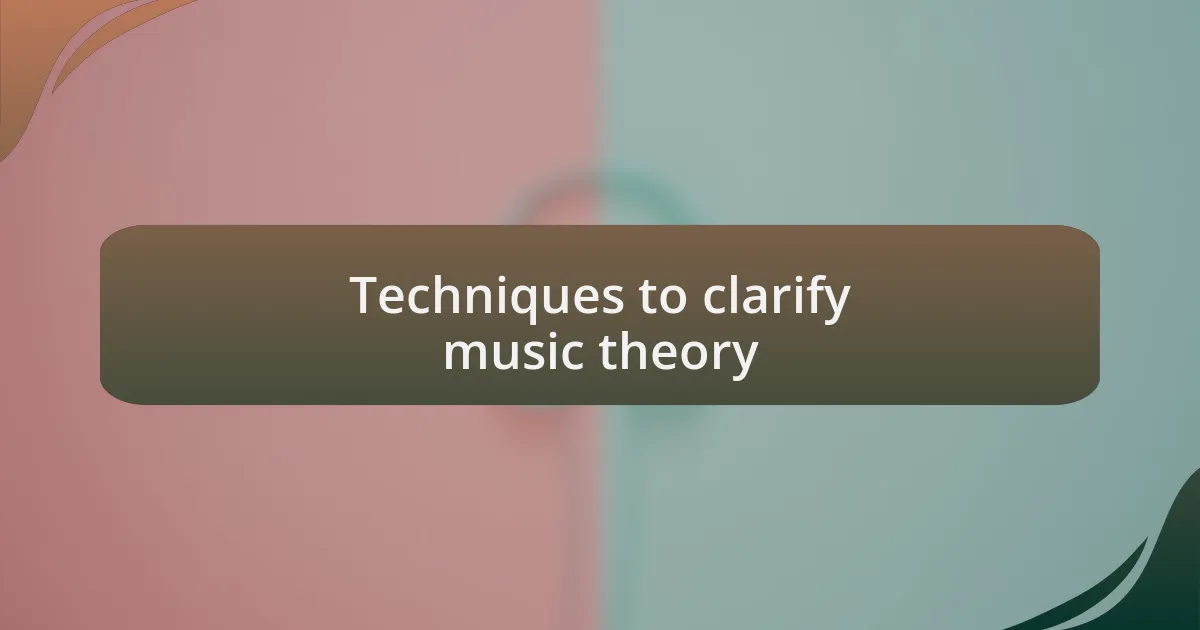
Techniques to clarify music theory
One effective technique I’ve found is using visuals, like chord charts and diagrams, to illustrate concepts. When I first used a visual representation of a scale, it clicked for me in a way that dry text never did. Have you ever seen a diagram that made you suddenly understand something that felt overwhelming before? It’s astonishing how images can simplify complex ideas.
Incorporating hands-on activities can also significantly enhance understanding. I remember a workshop where we created music collaboratively, applying theory in real-time. This not only made the learning process fun but also allowed us to explore how theoretical concepts translate into actual music-making. Isn’t it amazing how putting theory into practice can help solidify those abstract concepts?
Finally, storytelling can be a powerful tool to clarify music theory. Sharing anecdotes from famous musicians about their own journeys through learning theory can make the subject more relatable. When I heard how a well-known artist struggled with the same concepts that confused me, it motivated me to keep pushing through. Have you ever felt inspired by someone else’s story? Those connections can transform how we perceive music theory, turning it from a daunting task into an engaging adventure.
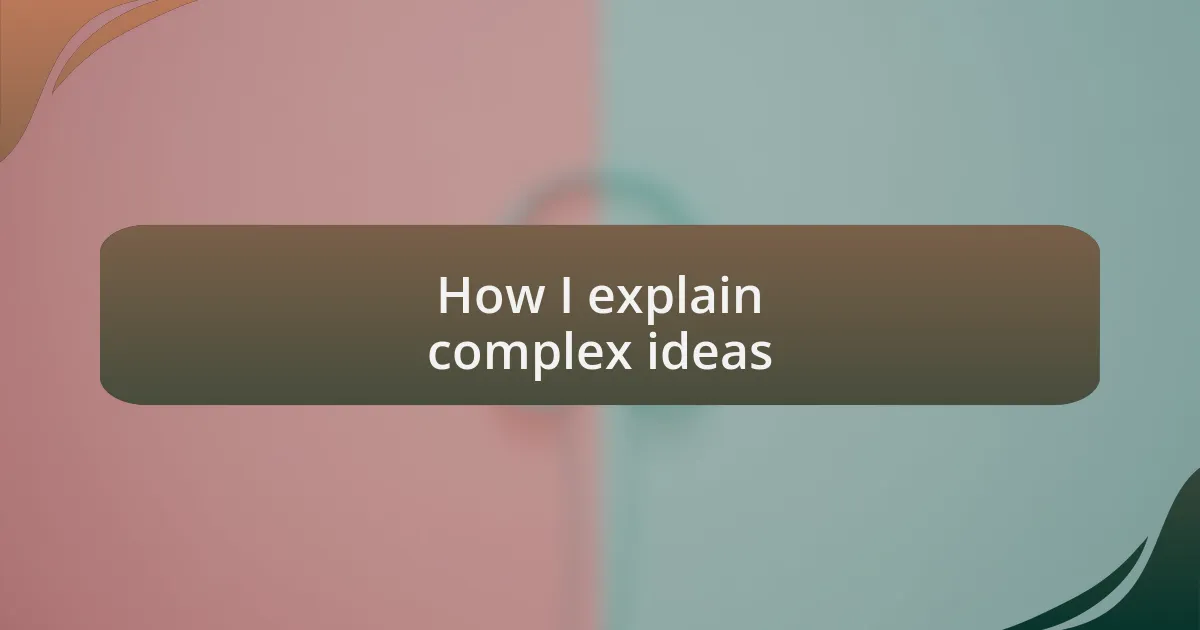
How I explain complex ideas
When explaining complex ideas in music theory, I find that breaking them down into smaller, digestible parts is key. For example, when I teach about intervals, I often start by relating them to familiar sounds, like a happy or sad feeling that a note can evoke. Have you ever noticed how certain notes instantly convey specific emotions? This simplification not only makes the material less intimidating but also allows learners to connect emotionally with the concepts.
To further clarify challenging topics, I always incorporate analogies that relate to everyday experiences. I once compared chord progressions to storytelling, where each chord represents a different character or plot twist. This analogy resonated with my students—they began to see music not just as notes on a page, but as a narrative unfolding through sound. Have you ever realized how a well-crafted song can tell a story? That realization can spark a deeper understanding of the structure behind it.
Lastly, I rely on real-time feedback during lessons to gauge understanding. I remember a session where I noticed confusion around seventh chords. Instead of pushing through, I paused, encouraged questions, and asked students to articulate what was unclear. What if the answer lies in their perspective? By fostering this open dialogue, I learned that addressing misconceptions on the spot not only clears up confusion but also builds confidence in tackling complex ideas head-on.
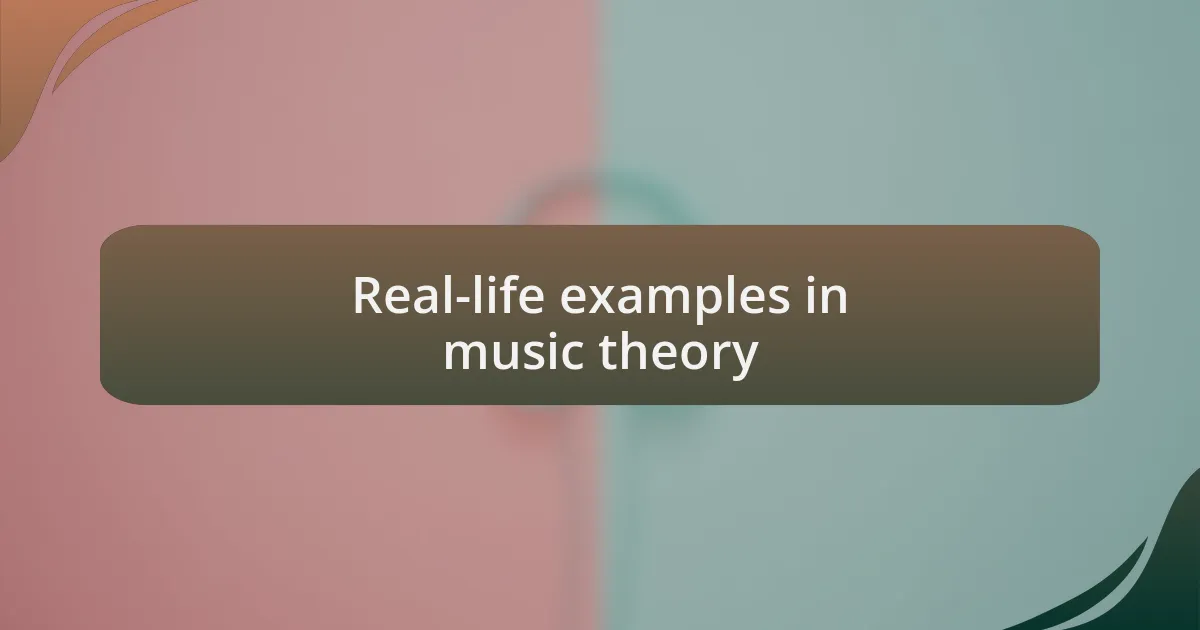
Real-life examples in music theory
When I think about real-life examples in music theory, one story always comes to mind. During a lesson on major and minor scales, I invited my students to identify the feeling associated with each. A student remarked that the major scale felt like a bright, sunny day, while the minor scale brought to mind a rainy afternoon. It struck me then how deeply music is intertwined with our daily experiences and emotions. Have you ever felt that shift in mood just by hearing a simple melody?
One day, while discussing harmonic progression, I used a popular song that all my students knew. I thought of “Let It Be” by The Beatles—its chord changes are so familiar yet profound. I encouraged my students to analyze how each chord transforms the emotional landscape of the song. They were amazed to realize that each transition mirrored a journey through joy and melancholy. How cool is it that something as structured as chord progressions can evoke such a wide range of feelings?
I also remember a time when I introduced the concept of rhythm using clapping games in class. It was a light-hearted way to demonstrate syncopation and time signatures. Students would tap out complex rhythms and laugh as they struggled to keep up, and that sense of playfulness really helped them grasp the rules of rhythm without fear. Have you ever clapped along to a beat and lost track of time? That enjoyment can transform theory from a dull lesson into an engaging activity that resonates far beyond the classroom.
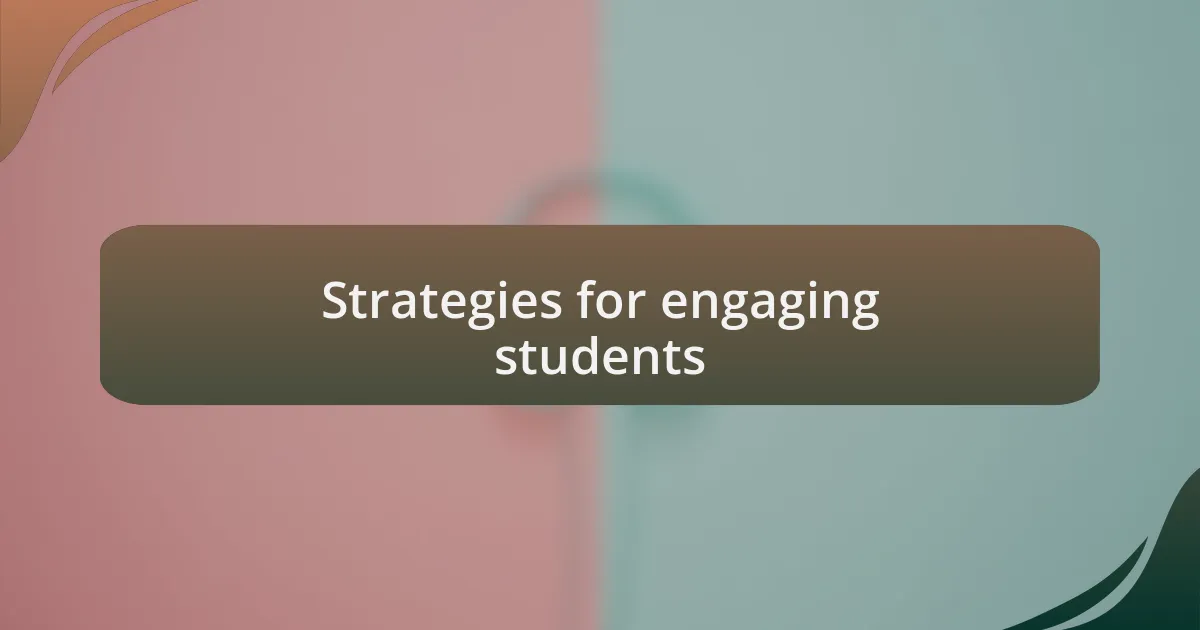
Strategies for engaging students
One effective strategy I’ve employed is to incorporate technology into lessons. For instance, I often use music composition software where students can create their own pieces. Watching their faces light up when they hear their ideas come to life is truly rewarding. Have you ever felt that rush of excitement when you realize your creativity can translate into something tangible? It’s a powerful moment in the learning process.
Another approach I love is using group projects that blend creativity and collaboration. Recently, I assigned my students to create a mashup of two different songs while analyzing their musical structures. The discussions that sprang from their different interpretations were fascinating. Isn’t it interesting how different perspectives can lead to diverse solutions? It fosters a deeper understanding of music theory by encouraging students to think critically and creatively about concepts.
Lastly, I’ve found that storytelling can be a compelling way to engage students. I share my own musical journey, including challenges and victories along the way. When I discuss my first experience with improvisation and the fear of making mistakes, it resonates with students. They often share their own fears, which opens up a genuine dialogue. Doesn’t it feel good to know you’re not alone in your struggles? By creating a safe space for vulnerability, I can help students feel more connected to the material and to each other.
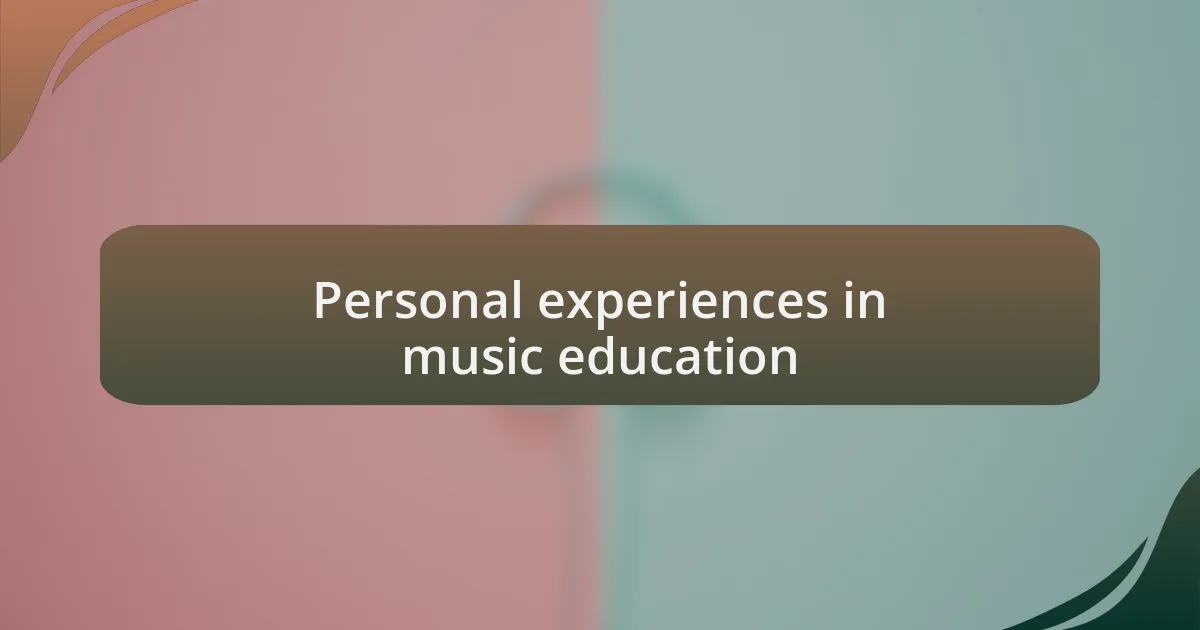
Personal experiences in music education
I remember my early days as a music student, sitting in a classroom filled with uncertainty about complex theories. One day, a teacher handed me a piece of sheet music and asked me to interpret it in my own words. That moment was eye-opening; suddenly, the intimidating symbols became a story I could narrate. Have you ever faced a daunting concept and found clarity in expressing it differently?
In my teaching career, I introduced a “sound exploration” day where students could play with different instruments and create their own simple melodies. One student, who was typically shy, found his voice through a quirky tune on a ukulele, and the joy on his face was unforgettable. It reminded me how vital it is to create an environment where all students feel safe to explore their musical identities. Do you recall a time when you discovered your passion in an unexpected way?
I vividly recall an instance during a music theory class when I used imagery and emotion to teach harmonic progressions. After analyzing the relationship between different chords, I asked students to describe how each one made them feel. The classroom transformed into a lively discussion about emotions, revealing how much music is tied to our personal experiences. Isn’t it fascinating how harnessing our feelings can deepen our understanding of technical aspects in music?